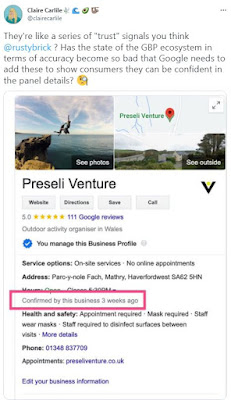When looking at a brand’s online presence, sure it’s
important to be active and engaged on social media. But it’s just as important,
if not more important, to make sure you have a highly functioning website.
I like to think of attracting leads, digitally, like this:
social media is the outside facing of a company, business, etc. The website is what
you see once you’re through the door from the outside.
Both need to make strong impressions. You need to capture
their attention on social media. Then, you need to keep them “in the building”
(or the website).
When considering a website’s functionality, navigation ease
is an important part of it. But one area that is often overlooked and has high
value as well is design.
Design matters.
And by design, it’s more than just easy-to-find
call-to-actions. It also includes text size, colors, etc.
All of the above details matter when it comes to making a
strong first impression to a user to your website, but also in terms of SEO
results as well.
Let’s explore the key elements to an effective website, in
this case, from a SEO results standpoint.
HEADLINES
There is a specific structure and flow you should follow
when designing a website. It’s not only helpful for the users, but also for web
search crawling tools as well.
Search engines, as well as human users, use headings to crawl
through websites to understand the site’s content. Once a search engine understands
the content, it better understands where and when to rank your site in search
results.
Each page should have a single H1 and subheads in a
sequential, descending order that doesn’t skip any levels.
For each headline after an H1 headline (sometimes seen as
Headline1 in some templates), follow a hierarchy (H2, H3, H4 and so on). If you
need to use subheads, use a paragraph-type text style.
Something else to consider, H1 headlines need to be short
and clear. The further down you go in the headline hierarchy, the longer a
headline can be.
PRIORITIZE WEB DESIGN FOR MOBILE OVER DESKTOP
According to Statista, the latest number of smartphone users
in the world today (as of July 2022) is 6.6 billion, or 83.7% of the world's
population.
Because of that, mobile-friendly websites are highly valued
in SEO. Search engines can detect mobile devices, and they assign better results
to websites that are mobile friendly over ones that aren’t.
Make sure your website automatically responds and adjusts to
screen size and not make it reliant on the user to do it. That’s a negative
experience and likely a lead lost.
Another thing to consider: videos.
Videos on desktop sites often look nice and add spice to a
website. Given screen sizes with mobile devices, that same video likely won’t
look as good on mobile. In addition, video slows down website loading speed,
which diminishes not only SEO results, but also user-friendly navigation.
BE AWARE OF SITE LOADING SPEED
Page speed is considered one of the leading SEO ranking
factors. Impatient users expect websites to load within seconds. Improve speed
by contracting with a good host and enabling browser caching.
What also slows a site’s loading speed includes the previously
mentioned videos component, large images and colors. A sharp-looking desktop
site with all sorts of graphics and animations may look great and appealing on
a desktop, but that may not transfer to the mobile site.
I often recommend, the simpler the design the better.
KNOW WHY USERS GO TO YOUR SITE
Sounds obvious, right? But it shouldn’t be overlooked.
Earlier, I talked about the key to a first impression.
Attracting the users quickly and then holding them can also improve or diminish
SEO results. Say if you are in the top spot on the SERP (search engine results
page), that’s great. But, if the user immediately clicks back to the SERP and
clicks a different link, that sends a trigger to search engines that the
previous result didn’t apply to them. If those build, that’ll hurt SEO result.
IN SUMMARY
A visually pleasing website promotes users’ confidence in
your brand, which causes them to stay on your site longer, which then improves your
SEO results. Place high value on web-friendly images, a text hierarchy and
simple graphic elements (such as video), and SEO results will improve.
One last point, always be sure your meta descriptions are up
to date and accurate. Also include these on images and videos, if possible.
.jpg)





.jpg)







.jpg)



























